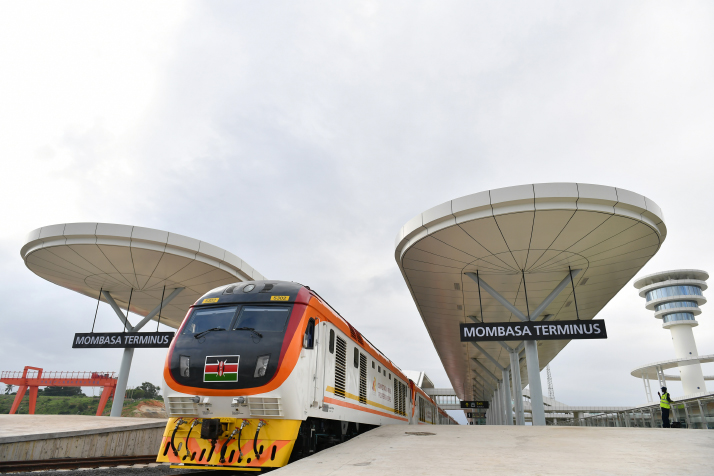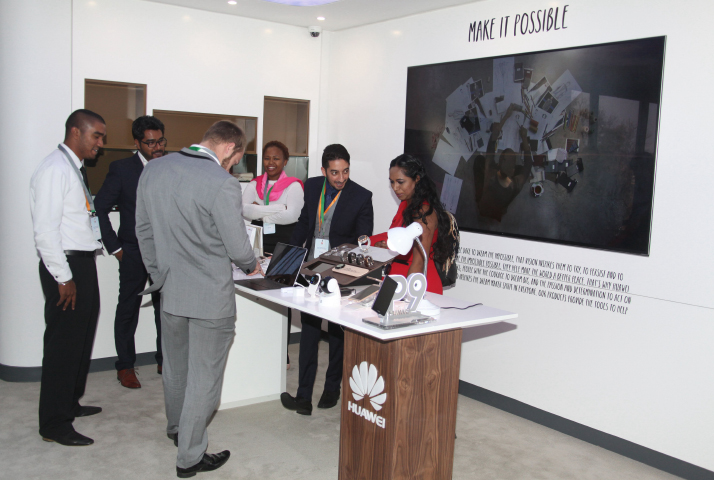|
||||||||||
| Home Nation World Business Opinion Lifestyle ChinAfrica Multimedia Columnists Documents Special Reports |
|
||||||||||
| Home Nation World Business Opinion Lifestyle ChinAfrica Multimedia Columnists Documents Special Reports |
| Business |
| Investment Bells Ringing |
| Belt and Road Initiative opens up more opportunities for East Africa |
| By Yu Nan | VOL.10 January 2018 ·2017-12-29 |

It's just been over half a year since Kenya inaugurated its standard gauge railway, but already the transport system is seeing heavy demand from travelers between Nairobi and Mombasa.
The China-built project, changing Kenya's landscape with brightly-colored trains and sparkling modern stations, is a worthy example of tangibly turning the vision of the Belt and Road Initiative into reality in Africa.
China is working with its African partners to realize the modernization of the continent's infrastructure, especially in East Africa, according to experts.
This resonates with a recent report by leading global law firm Baker McKenzie and global strategy consultancy Silk Road Associates, titled Belt & Road: Opportunities & Risk - The Prospects and Perils of Building China's New Silk Road, which says East African countries have the potential to become major destinations of Chinese outbound investment under the Belt and Road Initiative.
Prioritizing infrastructure
Statistics show that the development of China-Africa relations has picked up speed since the Johannesburg Summit of the Forum on China-Africa Cooperation held in December 2015 in South Africa, with major infrastructure cooperation projects gaining momentum and bearing fruit.
Apart from the Mombasa-Nairobi Standard Gauge Railway, Kenya's largest infrastructure project in over 50 years, major projects with a heavy Chinese presence included the Addis Ababa-Djibouti railway, Africa's first cross-border electric railway, the 680-meter-long Kigamboni Bridge, the first of its kind in East and Central Africa, connecting Tanzania's largest city Dar es Salaam with Kigamboni across Kurasini Creek, and Addis Ababa Light Rail Transit (AA-LRT) in Ethiopia.
According to the report, "East Africa is a more integral part of the Belt and Road Initiative owing to Djibouti's ports, Ethiopia's manufacturing and the region's existing plans to connect rail, road and energy networks."
Kenya Railways Corp. Managing Director Atanas Maina said that Monbasa-Nairobi Standard Gauge Railway will promote the development of many industries, including agriculture, mining, manufacturing, energy and tourism, drive the formation of towns along the line, create jobs and bring higher income for workers. His view was echoed by Rob Hersov, Chairman of Invest Africa, a business consulting organization, who cites AA-LRT in Ethiopia as a telling example that shows Chinese investments can bring real benefits to locals, and give strong impetus to the country's economy.
However weak infrastructure and Internet connection across the continent is a constraint on trade growth among African countries and international investment attraction, said He Wenping, Researcher with Institute of West-Asian and African Studies under China Academy of Social Sciences.
"One important engine under the Belt and Road Initiative is infrastructure building and interconnectivity. It will not only drive the development of the countries along the Belt and Road and help Chinese companies explore new international markets, but also bring new opportunities for the whole African continent," she said.

Investment expansion
The World Bank estimates that Africa needs about $93 billion annually to bridge its infrastructure gap. Moreover, according to Ernst & Young's latest Africa Attractiveness report, China has already invested in 293 projects in Africa since 2005, totaling an investment outlay of $66.4 billion.
The underdeveloped infrastructure such as energy and transportation will still attract increased Chinese investment to the continent in the next five years, the Baker McKenzie report noted. By 2025, benefits from the Belt and Road Initiative will spread to other sectors due to improved infrastructure, especially in such burgeoning sectors as technology, telecommunications and manufacturing, added the report.
While infrastructure development has been the primary Belt and Road driver, other sectors will emerge to play a role. The report indicated that there is an increased entry of Chinese smartphone brands to Africa.
The market share of Shenzhen-based Transsion's mobile brands reached 38 percent in Africa in 2016, according to the market intelligence company International Data Corp. It means that for every three mobile phones sold on the continent, one is made by Transsion.
Transsion's investments in many African countries have not only made it a household brand, but also brought real benefits to local people. In 2011, the company set up a smartphone plant in Ethiopia, which created more than 1,500 jobs for local workers.
While producing handsets for global customers, Huawei has ventured into infrastructure for mobile services to get local people connected to the wider world. Since 2013, the Chinese telecommunications giant has worked with Zambia Information and Communications Technology Authority and local carriers to deliver network coverage to remote areas. In 2014, it helped connect more than 500 villages for the first time by installing 169 base stations in remote areas of the country.
Positive impact
According to observers, accelerating the development of infrastructure in areas such as energy, transportation and information and communication technology has become a broad consensus among African countries in driving economic growth and transformation, but financing has been a huge challenge.
In early 2017, the International Monetary Fund (IMF) cited an infrastructure boom in Djibouti. Data from the IMF pointed out that the growth of the small country in the Horn of Africa is estimated to have reached 6.5 percent in 2016. The country also targets medium-term growth of 7.5-10 percent per year through infrastructure investment. China is financing many of the projects, including a port and a water pipeline connecting Ethiopia.
China has become the leading source of foreign direct investment on the continent, noted Lemma Senbet, Executive Director of the African Economic Research Consortium, a Nairobi-based economic policy research organization serving Africa. "I regard Chinese engagement with Africa as truly transformational in trade, investments and infrastructure development. There has been positive impact on Africa's growth trajectory."
Stanley Jia, Chief Representative of Baker McKenzie in Beijing, echoed Senbet's opinion. He said the Belt and Road Initiative "is and will continue to be the most important and impactful macroeconomic undertaking in the world, for at least the next 10 years."
Jia added that the scale and ambition of the Belt and Road Initiative means there will be plenty of opportunities for local and international partners in a wide variety of sectors that can work hand in hand with Chinese organizations for mutual benefit.
| About Us | Contact Us | Advertise with Us | Subscribe |
| Copyright Beijing Review All rights reserved 京ICP备08005356号-5 京公网安备110102005860号 |